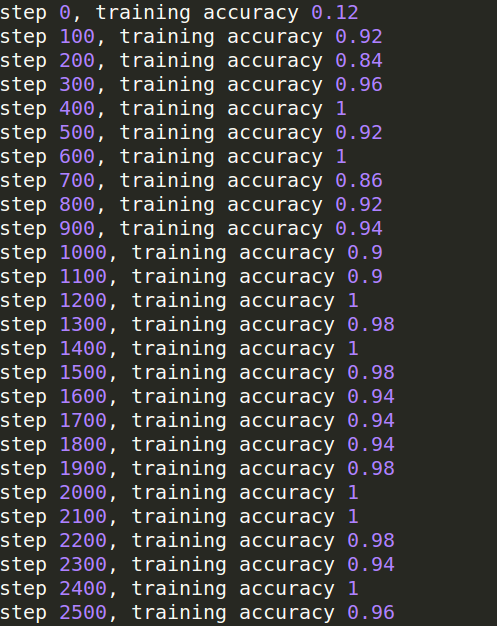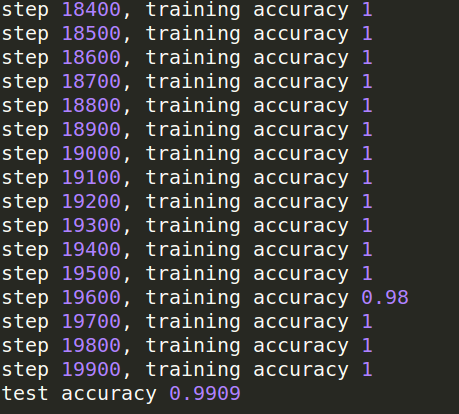TensorFlow学习之实现深度卷积分类器
2018-03-07 23:07
316 查看
1 利用TensorFlow在MNIST数据上构建深度卷积分类器
数据集:MNIST 数据,MNIST是一个入门级的计算机视觉数据集,包含各种手写体数字图片
本文分为两部分(1)softmax模型实现
(2)深度卷积分类器实现
2 实验代码及结果截图
#coding:utf-8
#softmax模型
#下载数据
from tensorflow.examples.tutorials.mnist import input_data
mnist = input_data.read_data_sets('MNIST_data', one_hot=True)
import tensorflow as tf
#创建计算图
sess=tf.InteractiveSession()
#创建计算图的输入和输出
x=tf.placeholder("float",shape=[None,784])#784是指单张展开的MNISt图片的维度数
y_=tf.placeholder("float",shape=[None,10])
#为模型定义权重和偏置
w=tf.Variable(tf.zeros([784,10]))
b=tf.Variable(tf.zeros([10]))
sess.run(tf.initialize_all_variables())
#预测分类和损失函数
y=tf.nn.softmax(tf.matmul(x,w)+b)
#最小化损失函数
cross_entropy=-tf.reduce_sum(y_*tf.log(y))
#训练模型
train_step=tf.train.GradientDescentOptimizer(0.01).minimize(cross_entropy)
for i in range(1000):
batch=mnist.train.next_batch(50)
train_step.run(feed_dict={x:batch[0],y_:batch[1]})
correct_prediction=tf.equal(tf.argmax(y,1), tf.argmax(y_,1))
accuracy=tf.reduce_mean(tf.cast(correct_prediction,"float"))
print "test accuracy:", accuracy.eval(feed_dict={x:mnist.test.images,y_:mnist.test.labels})

#初始化函数
def weight_variable(shape):
initial=tf.truncated_normal(shape,stddev=0.1)
return tf.Variable(initial)
def bias_variable(shape):
initial=tf.constant(0.1,shape=shape)
return tf.Variable(initial)
#卷积和池化
def conv2d(x,w):
return tf.nn.conv2d(x,w,strides=[1,1,1,1],padding='SAME')
def max_pool_2x2(x):
return tf.nn.max_pool(x,ksize=[1,2,2,1], strides=[1,2,2,1], padding='SAME')
#第一层卷积
w_conv1=weight_variable([5,5,1,32])
b_conv1=bias_variable([32])
x_image=tf.reshape(x,[-1,28,28,1])
h_conv1=tf.nn.relu(conv2d(x_image,w_conv1)+b_conv1)
h_pool1=max_pool_2x2(h_conv1)
#第二层卷积
w_conv2=weight_variable([5,5,32,64])
b_conv2=bias_variable([64])
h_conv2=tf.nn.relu(conv2d(h_pool1,w_conv2)+b_conv2)
h_pool2=max_pool_2x2(h_conv2)
#密集连接层
w_fc1=weight_variable([7*7*64,1024])
b_fc1=bias_variable([1024])
h_pool2_flat=tf.reshape(h_pool2,[-1,7*7*64])
h_fc1=tf.nn.relu(tf.matmul(h_pool2_flat,w_fc1)+b_fc1)
#减少过拟合
keep_prob=tf.placeholder("float")
h_fc1_drop=tf.nn.dropout(h_fc1, keep_prob)
#输出层
w_fc2=weight_variable([1024,10])
b_fc2=bias_variable([10])
y_conv=tf.nn.softmax(tf.matmul(h_fc1_drop,w_fc2)+b_fc2)
#训练和评估模型
cross_entropy=-tf.reduce_sum(y_*tf.log(y_conv))
train_step=tf.train.AdadeltaOptimizer(1e-4).minimize(cross_entropy)
correct_prediction=tf.equal(tf.argmax(y_conv,1), tf.argmax(y_,1))
accuracy=tf.reduce_mean(tf.cast(correct_prediction,"float"))
sess.run(tf.initialize_all_variables())
for i in range(20000):
batch=mnist.train.next_batch(50)
if i%100==0:
train_accurcy=accuracy.eval(feed_dict={x:batch[0],y_:batch[1],keep_prob:1.0})
print "step:",i,"train_accurcy:",train_accurcy
train_step.run(feed_dict={x:batch[0],y_:batch[1],keep_prob:0.5})
print "test accuracy:",accuracy.eval(feed_dict={x:mnist.test.images,y_:mnist.test.labels,keep_prob:1.0})


运行的结果就不所有都截图了,温馨提示:后面的程序运行起来会很慢很慢,需要将近半个小时才可以完成;
3 从两次的结果可以看出,准确性明显增加
数据集:MNIST 数据,MNIST是一个入门级的计算机视觉数据集,包含各种手写体数字图片
本文分为两部分(1)softmax模型实现
(2)深度卷积分类器实现
2 实验代码及结果截图
#coding:utf-8
#softmax模型
#下载数据
from tensorflow.examples.tutorials.mnist import input_data
mnist = input_data.read_data_sets('MNIST_data', one_hot=True)
import tensorflow as tf
#创建计算图
sess=tf.InteractiveSession()
#创建计算图的输入和输出
x=tf.placeholder("float",shape=[None,784])#784是指单张展开的MNISt图片的维度数
y_=tf.placeholder("float",shape=[None,10])
#为模型定义权重和偏置
w=tf.Variable(tf.zeros([784,10]))
b=tf.Variable(tf.zeros([10]))
sess.run(tf.initialize_all_variables())
#预测分类和损失函数
y=tf.nn.softmax(tf.matmul(x,w)+b)
#最小化损失函数
cross_entropy=-tf.reduce_sum(y_*tf.log(y))
#训练模型
train_step=tf.train.GradientDescentOptimizer(0.01).minimize(cross_entropy)
for i in range(1000):
batch=mnist.train.next_batch(50)
train_step.run(feed_dict={x:batch[0],y_:batch[1]})
correct_prediction=tf.equal(tf.argmax(y,1), tf.argmax(y_,1))
accuracy=tf.reduce_mean(tf.cast(correct_prediction,"float"))
print "test accuracy:", accuracy.eval(feed_dict={x:mnist.test.images,y_:mnist.test.labels})

#初始化函数
def weight_variable(shape):
initial=tf.truncated_normal(shape,stddev=0.1)
return tf.Variable(initial)
def bias_variable(shape):
initial=tf.constant(0.1,shape=shape)
return tf.Variable(initial)
#卷积和池化
def conv2d(x,w):
return tf.nn.conv2d(x,w,strides=[1,1,1,1],padding='SAME')
def max_pool_2x2(x):
return tf.nn.max_pool(x,ksize=[1,2,2,1], strides=[1,2,2,1], padding='SAME')
#第一层卷积
w_conv1=weight_variable([5,5,1,32])
b_conv1=bias_variable([32])
x_image=tf.reshape(x,[-1,28,28,1])
h_conv1=tf.nn.relu(conv2d(x_image,w_conv1)+b_conv1)
h_pool1=max_pool_2x2(h_conv1)
#第二层卷积
w_conv2=weight_variable([5,5,32,64])
b_conv2=bias_variable([64])
h_conv2=tf.nn.relu(conv2d(h_pool1,w_conv2)+b_conv2)
h_pool2=max_pool_2x2(h_conv2)
#密集连接层
w_fc1=weight_variable([7*7*64,1024])
b_fc1=bias_variable([1024])
h_pool2_flat=tf.reshape(h_pool2,[-1,7*7*64])
h_fc1=tf.nn.relu(tf.matmul(h_pool2_flat,w_fc1)+b_fc1)
#减少过拟合
keep_prob=tf.placeholder("float")
h_fc1_drop=tf.nn.dropout(h_fc1, keep_prob)
#输出层
w_fc2=weight_variable([1024,10])
b_fc2=bias_variable([10])
y_conv=tf.nn.softmax(tf.matmul(h_fc1_drop,w_fc2)+b_fc2)
#训练和评估模型
cross_entropy=-tf.reduce_sum(y_*tf.log(y_conv))
train_step=tf.train.AdadeltaOptimizer(1e-4).minimize(cross_entropy)
correct_prediction=tf.equal(tf.argmax(y_conv,1), tf.argmax(y_,1))
accuracy=tf.reduce_mean(tf.cast(correct_prediction,"float"))
sess.run(tf.initialize_all_variables())
for i in range(20000):
batch=mnist.train.next_batch(50)
if i%100==0:
train_accurcy=accuracy.eval(feed_dict={x:batch[0],y_:batch[1],keep_prob:1.0})
print "step:",i,"train_accurcy:",train_accurcy
train_step.run(feed_dict={x:batch[0],y_:batch[1],keep_prob:0.5})
print "test accuracy:",accuracy.eval(feed_dict={x:mnist.test.images,y_:mnist.test.labels,keep_prob:1.0})


运行的结果就不所有都截图了,温馨提示:后面的程序运行起来会很慢很慢,需要将近半个小时才可以完成;
3 从两次的结果可以看出,准确性明显增加
相关文章推荐
- TensorFlow深度学习笔记 实现与优化深度神经网络
- 深度学习FPGA实现基础知识14(如何理解“卷积”运算)
- 深度学习框架TensorFlow学习(二)----简单实现Mnist
- 深度学习框架TensorFlow学习----100行代码实现AlexNet
- TensorFlow 深度学习笔记 TensorFlow实现与优化深度神经网络
- 深度学习的TensorFlow实现
- 深度学习FPGA实现基础知识17(图像处理卷积运算 矩阵卷积)
- TensorFlow 深度学习笔记 TensorFlow实现与优化深度神经网络
- 【深度学习】使用tensorflow实现AlexNet
- Tensorflow深度学习入门——采用卷积和池化优化训练MNIST数据——代码+注释
- [置顶] 【深度学习】使用tensorflow实现VGG19网络
- TensorFlow 深度学习笔记 从线性分类器到深度神经网络
- TensorFlow 深度学习笔记 从线性分类器到深度神经网络
- 深度学习Caffe实战笔记(17)MATLAB实现卷积层卷积核权重的可视化
- TensorFlow 深度学习笔记 TensorFlow实现与优化深度神经网络
- (尤其是训练集验证集的生成)深度学习 tensorflow 实战(2) 实现简单神经网络以及随机梯度下降算法S.G.D
- Tensorflow 深度学习分布式实现方式
- 深度学习之卷积神经网络编程实现(二)
- TensorFlow深度学习笔记 从线性分类器到深度神经网络
- TensorFlow 深度学习笔记 TensorFlow实现与优化深度神经网络
